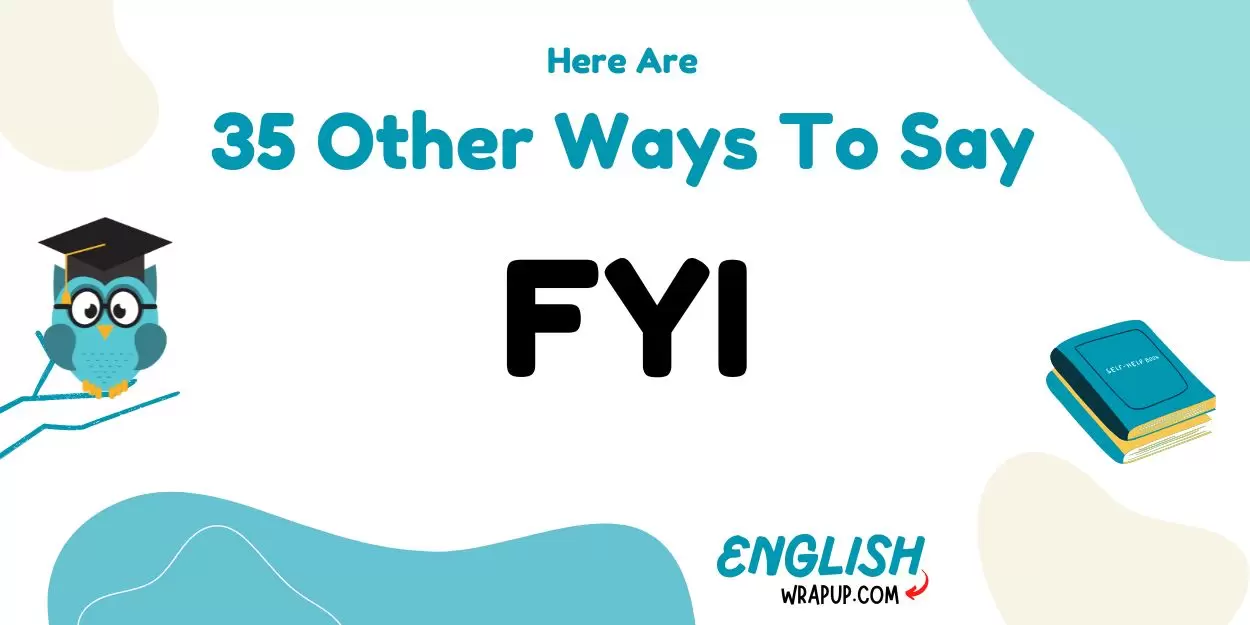When sharing information or providing updates, the phrase “FYI” (For Your Information) often serves as a convenient shorthand. However, there are numerous alternatives to express the same sentiment with a touch of variety and clarity.
Whether you’re communicating in a professional setting or among friends, these alternatives offer versatility and conveyance of essential information effectively.
Is it Professional to Say “FYI”
“FYI,” short for “For Your Information,” is a commonly used abbreviation in professional communication. Its usage depends on the context and the relationship with the recipient. Here are some considerations:
- Informality: “FYI” is relatively informal and may not be suitable for very formal or official communication, such as in legal or regulatory matters. However, it is widely accepted and commonly used in many professional settings, particularly in emails, memos, or internal communications.
- Clarity: It’s a concise way to inform someone about something without necessarily requesting action or a response. It’s often used to share information, updates, or relevant details that the recipient may find useful or interesting.
- Relationship: Consider the relationship and familiarity with the recipient. In more formal contexts or with individuals you don’t know well, a more explicit and complete explanation may be preferable.
What to say instead of “FYI”
- For your information.
- Just so you know.
- As an FYI.
- In case you weren’t aware.
- For your reference.
- Just a heads up.
- Thought you should know.
- To keep you informed.
- FYSA (For your situational awareness).
- For your attention.
- It’s worth noting that…
- As a reminder.
- To bring to your attention.
- It may interest you to know.
- To keep you in the loop.
- As a point of information.
- To let you know.
- To inform you.
- By the way.
- It should be noted that…
- In case it matters to you.
- To apprise you.
- In light of this information.
- To clue you in.
- For the record.
- Just a friendly FYI.
- To notify you.
- It’s important to mention that…
- To alert you.
- As a courtesy.
- It may be of interest to you that…
- To update you.
- To advise you.
- As a heads-up.
- To keep you apprised.
1. For your information.
“For your information.” is a straightforward and formal way to impart knowledge or updates to someone. It conveys the message clearly without any ambiguity.

2. Just so you know.
“Just so you know.” carries a friendly tone while still indicating that the information being shared is important or relevant.
3. As an FYI.
“As an FYI.” maintains the brevity of “FYI” while adding a touch of formality, making it suitable for professional contexts.
4. In case you weren’t aware.
“In case you weren’t aware.” suggests that the information being shared may be new or unexpected, encouraging the recipient to pay attention.
5. For your reference.
“For your reference.” implies that the information provided may be useful for future use or as a point of comparison.
6. Just a heads up.
“Just a heads up.” is a casual yet effective way to alert someone to important information or impending events.
7. Thought you should know.
“Thought you should know.” conveys a sense of thoughtfulness and consideration, indicating that the information being shared is significant.
8. To keep you informed.
“To keep you informed.” underscores the importance of staying up-to-date and aware of relevant developments or changes.
9. FYSA (For your situational awareness).
“FYSA (For your situational awareness).” is a more formal variant of “FYI,” often used in professional or military contexts to emphasize the importance of awareness.
10. For your attention.
“For your attention.” directs the recipient to focus on the information being presented, indicating its significance or urgency.
11. It’s worth noting that…
“It’s worth noting that…” draws attention to a particular aspect or detail that may be of interest or importance.
Other Ways To Say “I Am Honored”
12. As a reminder.
“As a reminder.” serves as a gentle prompt to recall previously discussed information or to reinforce key points.
13. To bring to your attention.
“To bring to your attention.” signals that the information being shared requires the recipient’s awareness or consideration.
14. It may interest you to know.
“It may interest you to know.” suggests that the information being presented could be of interest or relevance to the recipient.
15. To keep you in the loop.
“To keep you in the loop.” assures the recipient that they are being kept updated and informed about ongoing developments or events.
16. As a point of information.
“As a point of information.” highlights a specific detail or fact that contributes to the overall understanding of a topic or situation.
17. To let you know.
“To let you know.” is a simple and direct way to inform someone of something they may not be aware of.
18. To inform you.
“To inform you.” conveys the intent to share important or relevant information with the recipient.
19. By the way.
“By the way.” is a casual segue into sharing additional or supplementary information in a conversation.
20. It should be noted that…
“It should be noted that…” indicates that the information about to be presented is significant or noteworthy.
21. In case it matters to you.
“In case it matters to you.” suggests that the information being shared may have relevance or significance to the recipient.
22. To apprise you.
“To apprise you.” is a formal way to inform or update someone about a particular situation or development.
23. In light of this information.
“In light of this information.” contextualizes the information being presented and suggests that it may impact future actions or decisions.
24. To clue you in.
“To clue you in.” is a colloquial way to inform someone about something they may not be aware of.
25. For the record.
“For the record.” indicates that the information being shared is being noted or recorded for future reference.
26. Just a friendly FYI.
“Just a friendly FYI.” maintains the informality of “FYI” while adding a friendly and approachable tone.
27. To notify you.
“To notify you.” signals the recipient that they are being officially informed or alerted about something.
28. It’s important to mention that…
“It’s important to mention that…” emphasizes the significance of the information being shared and its relevance to the conversation.
29. To alert you.
“To alert you.” indicates that the information being presented requires the recipient’s immediate attention or action.
30. As a courtesy.
“As a courtesy.” suggests that the information being shared is being offered as a polite gesture or consideration.
31. It may be of interest to you that…
“It may be of interest to you that…” implies that the information being shared could be of relevance or significance to the recipient.

32. To update you.
“To update you.” communicates the intention to provide the recipient with the latest information or developments on a particular topic.
33. To advise you.
“To advise you.” indicates that the information being shared includes guidance or recommendations for the recipient’s benefit.
34. As a heads-up.
“As a heads-up.” alerts the recipient to upcoming events or changes, allowing them to prepare or take appropriate action.
35. To keep you apprised.
“To keep you apprised.” assures the recipient that they will be kept informed and updated on relevant matters as they unfold.
Final Thoughts
In conclusion, while “FYI” is a commonly used abbreviation for “For Your Information,” there are numerous alternatives available to convey the same message effectively. Whether you’re communicating in a professional or casual setting, choosing the right phrase can enhance clarity, tone, and overall communication effectiveness.
By incorporating these alternatives into your vocabulary, you can ensure that your messages are clear, concise, and tailored to your audience’s preferences and expectations.
So, the next time you’re sharing important information or providing updates, consider using one of these alternatives to “FYI” to make your communication more engaging and impactful.

I’m Olivia Martinez, the educational mind behind “English WRAP Up.” I’ve had a blast teaching and grading English tests like TOEFL, IELTS, BULATS, FCE, CAE, and PTEG. At English WRAP Up, we’re dedicated to turning your exam preparation into a success story. Let’s make your English skills shine—join me in the educational journey at English WRAP Up!



